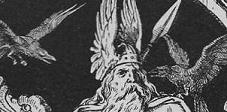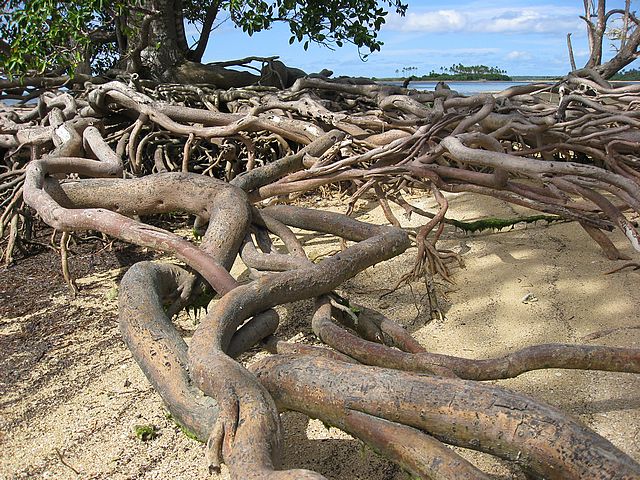The Poetic Edda: A Study Guide
The Speech of the Masked One

[PREVIOUS][MAIN][NEXT]
[HOME]
MS No. 2365 4to [R]
AM 748 I 4to [A]
Normalized Text:
Ormar fleiri liggja
vndr aski Yggdrasils,
en þat vf hyggi hverr ósviþra apa:
Goinn ok moinn,
þeir ero grafvitnis synir,
grabakr ok grafvolluþr,
opnir ok svafnir,
hygg ek, at æ scyli
meiþs qvisto má.
Ormar fleiri liggja
vnd aski Yggdrasils,
en þat of hyggi hverr ósvinnra apa:
goinn ok moinn,
þeirro Grafvitnis synir,
grabakr ok grafvolluþr,
ofnir ok svafnir,
hygg ek, at æ scyli
meiþs kvistv má.
34. Ormar fleiri liggja
und aski Yggdrasils,
en þat of hyggi hverr ósviðra apa:
Góinn ok Móinn,
þeir ro Grafvitnis synir,
Grábakr ok Grafvölluðr,
Ófnir ok Sváfnir,
hygg ek, at æ skyli
meiðs kvistu má.
in Icelandic Poetry
“The Song of Grimnir”
The Yale Magazine, Vol. 16
“The Song of Grimner”
Beneath the autumnal leaves that spread
The ground below the forest's head,
More hissing serpents daily glide,
Than e'er unwary Apa [1]spied.
Grafvitner's sons are long decreed,
Daily on the Ash to feed.
[1] APA, Apes.
Few can number the serpents that
lie beneath
The tree of ages; Goinn and Moinn, the sons
Of Grafvitner are there, and other four
Whose fate-allotted task it is to waste
Forever its branches, shooting forever anew.
in Edda Sæmundar Hinns Frôða
“The Lay of Grimnir”
in Corpus Poeticum Boreale
“The Sayings of the Hooded One”
under Yggdrasil’s ash,
than any one would think
of witless mortals:
Goin and Moin
-they are Grafvitnir’s sons -
Grabak and Grafvöllud,
Ofnir and Svafnir,
will, I ween,
the branches of that tree
ever lacerate.
More serpents lie under the ash Ygg's-steed than any foolish ape can know: Goin and Moin the sons of Grave-wolf, Greyback and Gravedigger, O. and S., I know will for ever be boring at the roots of the tree.
in Edda Saemundar
“The Sayings of Grimnir”
in The Poetic Edda
“Grimnismol: The Ballad of Grimnir”
34. More serpents lie under Yggdrasil's ash
than a witless fool would ween
Goin and Moin, the offspring of Grave-monster,
Grey-back and Grave-haunting worm,
Weaver and Soother, I ween they must ever
rend the twigs of the tree.
34. More serpents there are beneath the ash
Than an unwise ape would think;
Goin and Moin, Grafvitnir’s sons,
Grabak and Grafvolluth,
Ofnir and Svafnir shall ever, methinks,
Gnaw at the twigs of the tree.
[1] Nothing further is known of any of the serpents here listed, and the meaning of many of the names is conjectural. Editors have altered it in various ways in an attempt to regularize the metre.
in The Poetic Edda
“The Lay of Grimnir”
in The Elder Edda
“The Lay of Grimnir”
35. [More worms do lie the world-tree beneath
than unwise apes may ween:
Góin and Móin, which are Grafvitnir's sons,
Grabak and Grafvolluth;
Ofnir and Sváfnir[1] ay,
I fear me,
on that tree's twigs will batten.]
[1]
Several of these names have reference to the burrowing activities of worms and
snakes. The last two are names of Óthin; see St. 55 and note.
34. Under Yggdrasil hide more
serpents
Than dull apes dream of:
Goin and Moin, Grafvitnir's sons,
[missing line]
Sleepbringer, Unraveler, shall bite off
Twigs of that tree for ever.
in The Poetic Edda
“Grimnir’s Sayings”
in The Poetic Edda, Vol. III: Mythological Poems
“The Lay of Grimnir”
than any fool can imagine:
Goin and Moin, they are Grafvitnir's sons,
Grabak and Grafvollud,
Ofnir and Svafnir I think for ever will
bite on the tree's branches.
34. More worms are a-bed
beneath Yggdrasill’s Ash than
any dimwit dunce may dream of:
Soil Worm and Heath Worm —
they are sons of Grave Wolf—
Grey Back and Grave Digger,
Twister and Killer—
I think they will for ever erode
the twigs of the tree.
The Elder Edda: A Book of Viking Lore
'The Lay of Grimnir"
34. ‘More serpents lie under the ash Yggdrasil
than any dumb blockhead can believe;
Góin and Móin —Grafvitner’s sons—
Grey-back and Grafvöllud;
Ofnir and Sváfnir, I reckon must always
bite on the branches of the tree.
[HOME][GRÍMNISMÁL]
|
Svá er enn sagt: |
And it is further said: under Yggdrasill's stock Than every unwise ape can think: Góinn and Móinn (they're Grafvitnir's sons), Grábakr and Grafvölludr; Ófnir and Sváfnir I think shall aye Tear the trunk's twigs. |
| Grímnismál 33: | 1871 Bergmann | 1883 Vigfusson | 1908 Bray | 1923 Bellows | 1967 Auden/ Taylor |
2011 Dronke |
| Góinn: |
Of-Earth (Terreux) |
Soil Worm | ||||
| Móinn: |
Of-Clay (Argileux) |
Heath Worm | ||||
| Grafvitnir: |
Presages-of- the-tomb (Présage-de- tombeau) |
Grave-wolf | Grave-monster | "gnawing wolf" | Grave Wolf | |
| Grábakr: |
Gray-Back (Dos-gris) |
Greyback | Grey-back | "Gray-back" | Grey Back | |
| Grafvölluðr: |
Gray-Skin (Peau-grise) |
Gravedigger | Grave-haunting | "Field-Gnawer" | Grave Digger | |
| Ófnir: |
Blazing (Flambant) |
Weaver | "Bewilderer" | *Sleepbringer | Twister | |
| Sváfnir: |
Making-drowsy (Assoupissant) |
Soother | "Sleep-Bringer" | *Unraveler | Killer |
*Note: Auden and Taylor appear to have reversed the two names they translate (Ófnir and Sváfnir) in their edition.
"A myriad of voracious worms, with deathly names, are eating away the tree's branches incessantly."
The serpents, when treated allegorically are most often interpreted as forces of death and decay.
All of these, except Grafvölluðr, appear in a nafnaþulur (name-list) of serpent-heiti in Skáldskaparmál.
Most of their names appear in kennings of the type which call gold "a serpent's resting place" (i.e. its 'bed', 'pillow', 'seat', 'ground', etc). Nothing is known of them otherwise.
Niddhögg, named in Grímnismál 33 and 35, is the only mythological serpent assigned to Yggdrasil's roots that we learn of elsewhere (Völuspá 37 and 66). That and the broken meter of this stanza have lead some scholars to consider it an interpolation, in whole or part. Of it, Henry Bellows Adams (1923) writes:
"Nothing further is known of any of the serpents here listed, and the meaning of many of the names is conjectural. Editors have altered it in various ways in an attempt to regularize the metre."
"Stanzas 33-34 may well be interpolated, and are certainly in bad shape in the manuscripts. Bugge points out that they are probably of later origin than those surrounding them. Snorri [p. 98] closely paraphrases stanza 33, but without elaboration, and nothing further is known of the four harts. It may be guessed, however, that they are a late multiplication of the single hart mentioned in stanza 26, just as the list of dragons in stanza 34 seems to have been expanded out of Nithhogg, the only authentic dragon under the root of the ash."
In Medieval Scandinavia: An Encyclopedia (1988), Jeffrey A. Mazo observes:
"The number and selection of wisdom stanzas undoubtedly varied among oral performances of the poem, but there is no reason to discard stanzas as interpolations or to treat the extant written text as anything other than a coherent whole."
Góinn: "he who burrows himself into the earth" from go- = German gau.
Móinn: "one who lives on the Moor"
The names Góinn and gest-Móin appear in a nafnaþulur of sword-heiti in Skáldskaparmál. Góinn may also be used as a sword name, if ginninn is read as Góinn in HolmgB 5—(see Egilsson's Lexicon Poeticum s.v. Göinn), then Göinn's hurð is a shield, its wolf is a sword.
Göinn's name in used in kennings for gold:
Göinn's völlur, HolmgB 8
Göinn's leiti, SnE II 198
Göinn's sker, stett Egils. 3, 12, 18.
Krákumál 27 contains the expression Góinn byggvir sal hjarta "Góinn dwells in the hall's heart".
Móinn's name also appears in kennings for gold:
Móin's jörð, Ólsv 5, Nj 21
Móin's storð, Pl 18
Móins akr, Óð 21;
Móins sætti, Hl 18 b
Móins moerr, Árni 2, 2
Móins leið, Grettis. 11
Móinsheimar, "Móin's home", occurs as the name of a battle-field in Helgakviða Hundingsbana I, 46, and II, 24.
Móinn is also the name of a horse in a nafnaþular, according to Egilsson.
Grafvitnir is one of three names in Grímnismál ending with the suffix -vitnir. The other two are Þjóðvitnir in Grímnismal 21 (of Heimdall, or perhaps Fenrir) and Hróðvitnir in Grímnismál 39 (of the wolf Hati's father) .
"Vitnir" means "wolf", but the etymology of the word shows it to be related to the word "vit" = "sense, senses". Magnússon's Etymological Dictionary states that the original meaning of the word is "one with sharp senses".
Sveinbjörn Egilsson in his Lexicon Poeticum (1932) translates Grafvitnir as "burrowing- or grave-wolf", noting that the kenning beðr Grafvitnis, "Grafvitnir's bed" means gold, ESk 11, 6.
Gold is referred to as dúni Grafvitnis, 'Grafvitnir's pillow', in a list of gold-kennings from a stanza of the poem Bjarkamál, preserved in Skáldskaparmál.
Grafvölluðr: "he who burrows down into the ground"
Grábakr is also used of a serpent in Óð. 21
"Svafnir, m. [svefja], a sleep-maker, soother, Lat. sopitor."
Sveinbjörn Egilsson in his Lexicon Poeticum (1932) translates
the names as follows:
Ófnir: "weaver" (?)
Sváfnir : "the one who lulls to sleep"
In the sense of a snake-name, 'Ófnis jörd' and 'ýtis Ófnis jardar' are kennings for gold found in Sigv 5, 8. The kenning 'mars Ófnis' in Ragn VI, 2 refers to a ship.
Used as a name of Odin, 'ýseims Ófnir' is a kenning for war VGl 4.
As a kenning for sword, 'sónar Ófnir' in Isldr. 5 probably refers to the serpent, rather than Odin.
Sváfnir is used as a name of Odin in Vegtamskviða 3 and in Gylfaginning 2.
Sváfnirs sal, "Svafnir's hall", refers to Valhöll in Harv 11
Sváfnir is also the name of a legendary king, the eponym of the kingdom Svavaland (Helgakviða Hjörvarðsson, prose). Sváfnis dóttur, "Svafnir's daughter", Sigrlinn is the wife of King Hjörvarð in Helgakviða Hjörvarðsson 1 and 5.
When referring to a serpent, the kenning Svafnis látr in Grett 2, 9 refers to gold; as does Svafnis bryggva in d.s. Gd 16 (cf. Bugge). Fjör-svafnir is the name of a sword in Nj.
Sveinbjørn Egilsson's Lexicon Poeticum, under forkortelser, 'abbreviations'.

[PREVIOUS][MAIN][NEXT]
[HOME]
